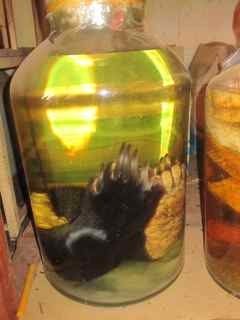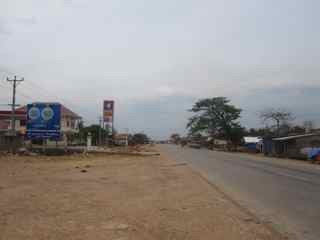As Conservationists Quietly Weep…
Some way into Laos, fresh out of Lao Bao, Vietnam, and heading for Savannakhet, our bus stops at what I guess is best compared to a service station/gas station/Little Chef.
You know. You have a pee. Eat and drink a little. Do a bit of shopping. Stretch your legs. Standard roadside stuff.
Now, rice whisky with snakes and scorpions in is pretty standard tourist stuff. It’s got similar “traveller chops” status in Vietnam to the Mezcal with the worm in it in Mexico, or those crab-infused cachacas they have in Brazil.
Bear paw whisky, on the other hand, is something else altogether.
So Z and I are in South-East Asian service station mode. Liking the look of the dishes behind the glass. Not fancying the dollar prices on the menu, not keen on the cosmetics, wondering about the sweets. Sniffing around for crisps. Generally checking the air.Then, stuck between the altar (next to the till — feng shui, eat your heart out!), the Communist-era vodka imports, the shelf of fake Johnnie Walker whisky, the kindling and the plastic water bottles of silted red stuff which is sold alongside fizzy pop in the ice boxes on the streets, there they are.
Gigantic jars of moonshine, with contents like a Tim Burton storyboard, writ very, very large.
In the middle of absolutely bloody nowhere (technically, somewhere near Phonhay, or conceivably said metropolis itself).
There are gallons of monitor lizards. Piles of lao-lao-sodden scorpions I sincerely hope were farmed, although they say it’s the small ones that are deadly. Whole birds. Hairy legs with cloven feet. Snakes. Roots. Honeycombs. Ugly intestinal crap.
And, the pièce de résistance, black bear paws, price on application only.
In an era where culture shock is generally lacking, this delivers the emotional goods so efficaciously that there must be a German compound word for the results. It’s worse than our dinner in Bokor National Park.
Even the Korean guys are shocked. (The Vietnamese are mildly amused, the Laos politely mystified, while the small remaining band of Europeans get out our cameras and snap a million holiday pics.)
Anywise, as I am psyching myself up to buy a glass of the red and brown silty stuff next time we’re at a plastic chair place on the Mekong — if it’s like Cambodia, it’ll be five cents a pop and completely undrinkable — yelling at Z to look at some horses (the first we’ve seen so far), an Indiana Jones-esque chanting echoes from the middle of nowhere, and an orange band appears across the road.
It’s monks. A whole bunch of monks. Followed by serried ranks of women in white, a straggling rabble of women in conical hats and dark pyjamas, and gents in their shirt sleeves. All of them loosely holding some token nylon ropes.
And a giant ivory-gold palanquin atop a knackered van, following the mourners under engine power, yet trailing behind the ropes, family riding shotgun, blown-up portrait on patrol.
Yep. It’s a funeral. Laos-style.
It takes me a while to realise that the mile-long tailback of pickups, vans and 4WDs trailing back behind the palanquin from nowhere into nowhere are not, in fact, a part of the cortege, but folk who have been attempting to get across the country on the only viable road for 50 miles each side.
They are very nice about it. They smile and wave, as I snap pictures and the bus driver smokes his fifth fag in succession, while Z scales a bunch of rubble, finds a chair leg and waves it in imperial salutation.
“That is very selfish of them,” he announces. “Imagine making the dead so much more important than the living.”
“Ah,” I say, authoritatively. “There is a very strong animist and ancestor-worship tradition in Laos, and people believe in spirits and ghosts.”
“So they think she can come back and get them?” he says.
I’m not quite sure what to say to that, though he’s pretty on the nail.
But we like it here. And, to be honest, if the funeral had been sufficiently grandiose to force us to stay the night, we’d probably have liked it there.



